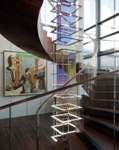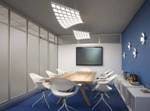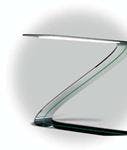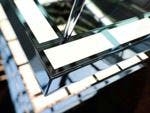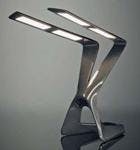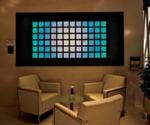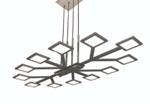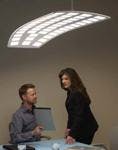OLEDs and LEDs share the characteristic of energy efficiency. Measured in terms of efficacy in lumens per Watt (lm/W), OLEDs use less energy than compact fluorescent sources but still trail LEDs significantly in efficacy. Of course OLEDs are far more efficient than incandescent sources.
The US Department of Energy (DOE) is actively promoting and investing in the development of both LED and OLED sources in their solid-state lighting (SSL) program. The DOE also updates a Multi-Year Program Plan (MYPP) each year that tracks the state of the two technologies relative to near- and long-term goals that the DOE believes can spur deployment.
IF you want to dig into the details of the current state of the technologies and the projections, the MYPP goes into great detail (www.ssl.energy.gov/techroadmaps.html), but let’s consider a summary of the situation. Warm-white packaged LED components are available with efficacy in the 100 lm/W range. Cool-white LEDs are available in the 150 lm/W range. The best shipping OLED panels have an efficacy in the 60 lm/W range. But many available products are 30 lm/W or less.
Looking forward, the DOE projects that, by 2017, OLEDs will reach the 110 lm/W range in efficacy. Of course LEDs will progress as well, and the DOE projects 150 lm/W for packaged warm-white LEDs by 2017.
System efficiency
It’s important to note that OLED-panel and packaged-LED efficacy figures aren’t necessarily directly comparable because what really matters is the system efficacy or efficiency. There are electrical losses associated with driving either type of light source. Luminaires that use LEDs generally have additional optical losses due to secondary optics or reflectors. In many cases with OLEDs, there is little or no optical loss because the panel is the planar light source.
Now consider an OLED product. The DOE projects 100% optical efficiency. Acuity Brands has announced a number of OLED products that were developed by the company’s OLED Lighting Design Center and are being sold by the company’s Winona brand. For example, the Winona Kindred luminaire (pictured) was announced at Lightfair International in 2011. The product uses 45 4×4-in panels manufactured by LG Chem. The panels are rated at 60 lm/W when producing 3000 cd/m2. Acuity specifies the system efficacy at 51 lm/W – percentage wise a much smaller drop than you see with LED fixtures.
Acuity is also generally more bullish than the DOE on expectations for higher OLED efficacy. “Our belief is long term OLEDs will match LEDs in terms of efficacy and lifetime,” said Mike Lu, director of OLED technology at Acuity. He pointed out that since the company first demonstrated an OLED product in 2009 that efficacy has tripled. He added, “In 2015 OLEDs will easily be within 10% of LEDs in efficacy.”
Decorative and custom
Still today, most OLED luminaires are far more decorative than functional. And many companies are selling the products that way with little concern over efficacy. After all, the energy efficiency is already better than most legacy sources.
It’s panels from the decorative line that are in the chandelier pictured on the cover and nearby. As is often the case with OLED lighting at this early stage in the technology’s development, that chandelier is a custom design by Kardorff Ingenieure Lighting Design done for a Deutsche Bank office in Berlin, Germany.
The chandelier was constructed of rectangular frames, each of which integrate four OLED panels. For each layer of the fixture, four of the rectangular structures are used to form a square. There are a total of 384 OLED panels in the chandelier. Philips hid the electronics for the OLED panels inside the frame. The power source is located in a remote closet. Control and power are routed to the panels via DALI/DMX connections over wires that are hidden in the slender pipes that hold the frames in place.
Sticker shock
Now the bank chandelier would have come at a hefty price regardless of the light source used. With any source there would be the cost of the work of a top notch design firm and the cost of the frames, driver electronics, and other materials. Still, OLEDs sell for a premium. Dietmar Thomas, communication specialists with Philips, said that the cost of the chandelier was in the EUR 100,000 ($126,000) range.
It’s extremely difficult to get an accurate read on prices for more mainstream OLED applications today. The fixtures on the market are selling in very low volumes and manufacturers such as Acuity and WAC Lighting aren’t publicly discussing prices. But some OLED-based desk lamps will give you a ballpark idea.
Both of the desk lamps have many expensive features such as carbon fiber materials used in the Victory lamp base. And both would be targeted at the luxury market regardless of light source. But clearly the OLEDs helped drive the prices high.
Manufacturing costs
High prices for now are due to high manufacturing costs. Philips’ Thomas says that currently OLEDs sell for EUR 6000 to EUR 7000 ($7600 to $8800) per square meter. Each panel can take as long as 30 minutes to manufacture depending on the complexity of the panel design and the number of layers of material used.
Philips has made a major investment in OLED manufacturing. In March 2011 the company announced a EUR 40 million ($50.5 million) investment in its Aachen, Germany OLED manufacturing facility. Thomas expects that by the end of 2013, the company will have the manufacturing time down to 2 minutes per panel. He said that will translate to prices around EUR 1000 ($1250) per square meter for panels.
Acuity’s Lu points to the DOE projections as an indicator for where costs are heading. He said the DOE projected a price of $25 per kilo lumen (klm) by 2015 and $9 per klm by 2020. Of course LED-based lighting will be in the $1 to $2 per klm range by 2020. Lu also added, “The cost of the source becomes a smaller and smaller fraction of luminaire costs” with falling prices.
Light output and life
Beyond price, there are also technical issues that lighting designers working with OLEDs and OLED luminaire developers need to consider. The good news is that OLED panel makers have largely conquered the problem of suitable light output that once challenged the industry, but panel longevity is closely tied to drive current and therefore output level.
For example, Lu said that if you double the current the lifetime drops by a factor of 3. The converse is also true, if you dim an OLED by 50% the lifetime increases by a factor of 3. Acuity is specifying its OLED luminaires to have an L70 life of 15,000 hours meaning the products will produce at least 70% of the initial lumen output over the course of that life.
Ironically, Acuity is not looking for brighter panels. “We would like to have the brightness stay at 3000 cd/m2 or no more than 4000 cd/m2 to help us avoid the glare issue,” said Acuity’s Peter Ngai, vice president of research and development. The 3000-cd/m2 level can provide task-level lighting of 50 fc. And people can look at the luminaire operating at that level comfortably without experiencing glare.
When LG Chem delivers its next-generation panel at an efficacy of 80 lm/W, part of that gain will come via greater lumen output. But Acuity will leverage that advancement by turning down drive current, maintaining 3000 cd/m2 output, and extending product lifetime. Lu expects lifetime of 20,000 to 25,000 hours for products based on the 80 lm/W panels.
Comparing performance
You have to be careful when comparing OLED panel and luminaire specs however, because the panel manufacturers use different techniques to boost output and efficacy. For example, in Philips’ GL350 performance-line panels, the luminance is 4000 cd/m2 based on 500 mA drive current. L50 lifetime is 10,000 hours. At first glance that appears to trail the performance of the LG Chem panels by a wide margin, but the comparison isn’t that simple.
There are ways to mitigate the halo effect. For example, LG Chem uses a 1×1-mm conductive grid embedded in the panel to evenly spread the current. Acuity’s Lu said that you can’t see the grid if you are more than a few feet from the fixture.
Philips, however, has made the decision to eliminate the use of a grid. The company hasn’t detailed how it is mitigating the halo effect, but those techniques are apparently one factor limiting efficacy. Still, Philips believes its decision will yield panels with a superior appearance.
Color OLEDs
Now let’s discuss reasons to consider near-term use of OLEDs despite the cost and technology issues. One reason could be tunable color. For example, Verbatim Lighting offers its Model 52800 panel in the Velve series (pictured) that offers both tunable white color and RGB color. The panels can produce white light over the range of 2700K to 6500K in correlated color temperature (CCT), along with colors. Panels are controlled via a DMX/DALI link.
Producing color OLEDs is more complicated than producing white ones. The color panels have to have one or more layers dedicated to producing red, green and blue light. And clearly the color panels trail white panels in performance today.
Jeanine Chrobak-Kando, business development manager at Verbatim, identified a number of reasons people may want to turn to OLEDs now. She said that because OLEDs don’t produce heat the way LEDs do, you can use the panels in proximity to wood, cloth, paper, and other materials. She referenced a Verbatim customer in Japan that had integrated panels into office partitions.
Chrobak-Kando also addressed the issue of luminaire lifetime. The Verbatim panels are rated for 8000 hours at L70. But Chrobak-Kando said the products are often being used in place of legacy sources that had a life of 1000 to 3000 hours, and asked “Why not give OLEDs a try?” Verbatim makes trying the panels easy. The driver is integrated on the panels and the company sells an evaluation kit with one panel for $949.
You may have heard that OLEDs can also enable flexible displays and panels that are translucent when off. For the most part, those features have been shown thus far in laboratory demonstrations more so than in shipping products.
Challenges
The challenge faced in working with OLEDs today is a lack of availability of a broad array of off-the-shelf products. Philips’ Thomas conceded that most projects are highly custom today. Philips created the Lumiblade Creative Lab at its Aachen facility that allows lighting designers and luminaire makers to experiment with the technology. And today, Philips generally helps customers engineer products including the required electronics. Thomas said, “We provide the OLED, and provide the right driver electronics to make the OLED work in the application.”
Acuity has announced perhaps the largest product line and a clearly stated goal of mainstreaming the technology. Acuity’s Ngai said the company wants to avoid a path that yields custom products that only a few people can afford. He said, “Our idea is to bring OLEDs into mainstream lighting.”
The Kindred and Revel products were introduced a year ago and are just ready for commercial deployment according to Jeannine Fisher, Acuity OLED director of lighting design and application. At Lightfair this year the company announced the Trilia and Canvis lines. Trilia comes in straight and triangular-like models with three spokes. They can be combined to create extensive custom designs. The Canvis family (pictured) includes panels suspended in a way that allows the luminaire to have flexibility in shape although the panels themselves are rigid.
Acuity also makes the case that its OLEDs are affordable if you design a space for maximum application efficiency. Essentially that means light the task areas that need light and minimize wasted light. Acuity has a White Paper on the topic. Presumably OLED fixtures are superior to fixtures based on fluorescent or LED sources when you optimize a lighting design for application efficiency. We also have a recent article in our sister publication LEDs Magazine that discusses application efficiency relative to planar lighting that is edge lit with LEDs.
Still the move of OLEDs beyond the decorative niche is clearly in the future. Proponents don’t doubt that it will happen. Most don’t honestly expect OLED to become the dominant light source for general illumination. Philips’ Thomas said, “We will always be a little bit more expensive.” Moreover OLEDs don’t have the directional capabilities that are a strength for LEDs in many applications.
At the recent 13th Annual Symposium on the Science and Technology of Lighting hosted by the Lighting Research Center at Rensselaer Polytechnic Institute, participants in a CTO panel agreed that LEDs will dominate and that technologies such as OLED will be a nice complement. But Philips’ Thomas insists that OELD lighting will be a household product by the end of 2015.

